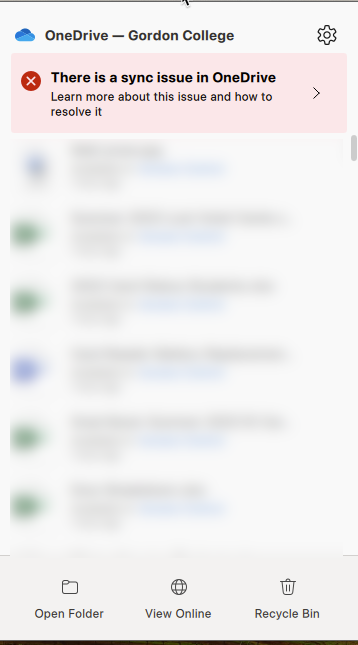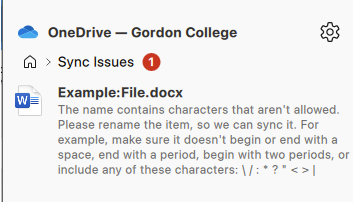Tip: Start typing in the input box for immediate search results.
OneDrive Migration: Sync Errors
Apple iCloud Desktop/Documents backup must be disabled to allow OneDrive backup to sync all of your documents
Sync Errors
What is a Sync Error?
A OneDrive sync error, specifically naming conflicts with bad symbols, occurs when the OneDrive sync app on a Mac encounters files or folders with names that include characters or symbols that are not compatible with the file system or cloud storage services. These "bad symbols" may include special characters, reserved characters, leading or trailing spaces, periods, or symbols that are not allowed in file names by macOS or OneDrive.

What does OneDrive Not Allow?
OneDrive's backup sync feature does not allow certain characters and file names due to compatibility and security reasons. These restrictions typically include special characters like \ / : * ? " < > |, and reserved names such as CON, PRN, AUX, NUL, COM1, COM2, COM3, COM4, COM5, COM6, COM7, COM8, COM9, LPT1, LPT2, LPT3, LPT4, LPT5, LPT6, LPT7, LPT8, and LPT9. Avoiding these characters and file names ensures a smooth and secure syncing experience with OneDrive. OneDrive's backup sync feature also restricts file names that have leading or trailing spaces, as well as those with periods at the end of the filename. These limitations are in place to maintain compatibility across different operating systems and to enhance security within the cloud storage environment. By avoiding these issues, users can ensure their files are synchronized smoothly and without potential errors or conflicts.
Types of Sync Errors
The image above illustrates what the OneDrive dialog will look like when you select the OneDrive cloud icon in the menu bar at the top of your Mac. When you click on this message, you will see files that are in an error state. Depending on the nature of the error, OneDrive has the ability to rename these files on your behalf. Simply select the 'rename' option, and OneDrive will resolve the issues blocking the backup of the affected files. Below we see an error message for a document, in this case there happens to be a leading space. This is something that may be difficult for us to locate but easy for the program to fix.

Ways to Resolve These Errors
There are instances when OneDrive is unable to automatically rename documents without requiring user input. In such cases, you will encounter a screen like the one shown below. You'll notice that there is no option for OneDrive to rename these files on your behalf. In situations like this, you can follow the steps below to identify and correct the files with errors.

To resolve naming conflicts with bad symbols in OneDrive on a Mac:
- Identify the Problematic File or Folder: Check the OneDrive sync error message to identify the specific file or folder causing the issue. It will typically provide information about the problematic name.
- Rename the File or Folder: You'll need to rename the file or folder to remove or replace the problematic symbols. Use only letters, numbers, hyphens, underscores, and periods in the file or folder name. Avoid using symbols like "*", "/", "", "?", ":", and others.
- Locate the File on Your Mac: Select the files from the OneDrive prompt to have finder open the location in question, the file will be highlighted in finder as seen in the image below. Alternatively you can open Finder and navigate to the location of the problematic file or folder on your local machine manually.
- Right-Click and Rename: Right-click on the file or folder with the problematic name and select "Rename" from the context menu.
- Edit the Name: Edit the name to remove any bad symbols. Ensure the name adheres to standard naming conventions.
- Save the Changes: Press "Enter" to save the changes. If prompted, confirm the change.
- Sync Again: Once you've renamed the file or folder on your Mac, the OneDrive app should automatically detect the change and attempt to sync it again without errors.

Repeat these steps for any other files or folders that encounter naming conflicts with bad symbols during the OneDrive sync process. Keep in mind that it's essential to maintain compatible file names to ensure smooth synchronization with cloud storage services like OneDrive.
Bulk Renaming Files
When there are multiple files with symbols that OneDrive does not allow, it is often easier to bulk rename files.
Steps for bulk renaming:
Open Finder: Click on the Finder icon in your Dock or press "Command + Space" to open Spotlight and search for "Finder," then press "Enter" to launch it.
Use the Search Bar:
- Start from either the Documents folder or the Desktop folder
- In the Finder window, locate the search bar in the upper-right corner (it looks like a magnifying glass).
- Click on the search bar to activate it.

Enter the Search Criteria: To search for files with the "/" symbol, type a forward slash ("/") in the search bar. You can also add more specific criteria, like a file extension, if needed. Be sure to select the filename contains option and double check that you are searching the Documents/Desktop folder
View Search Results: Finder will display all files and folders that match your search criteria in the main window.
Select Multiple Files:
- To bulk select files, click on the first file in the list.
- Then, hold down the "Command" key on your keyboard.
- While holding "Command," click on each file you want to select. They will be highlighted.
Rename the Selected Files:
- With the selected files highlighted, right-click (or Control-click) on one of the selected files.
- From the context menu, choose "Rename X Items" (X will be the number of items you've selected).
Choose a Renaming Format:
- In the Rename dialog box that appears, you can choose how you want to rename the files. You can use options like "Replace Text," "Add Text," or "Format" to change the file names.
- If you only want to remove the "/" symbol, select "Replace Text" and enter "/" in the "Find" field and leave the "Replace With" field empty.
Preview and Apply: After configuring the renaming options, click the "Preview" button to see how the files will be renamed.
Apply the Renaming: If you are satisfied with the preview, click the "Rename" button to apply the changes. Finder will bulk rename the selected files, removing the "/" symbol.
Confirm Changes: If Finder asks for confirmation to rename files, click "OK" or "Continue."
Your selected files will now be renamed, and the "/" symbol will be removed from their names. Please exercise caution when renaming files in bulk to avoid accidental data loss. It's a good practice to make a backup of important files before making significant changes.
Having Trouble or Need further assistance?
Please do not hesitate to contact CTS if you have any questions or need further assistance with this process. We are here to help and can provide additional guidance if needed.
If needed we can book a quick remote help session to go over the process with you
https://outlook.office365.com/owa/calendar/[email protected]/bookings/s/6oqQ-4bjXkORMZpnyi2KIw2
Questions? Comments?
Call: 978-867-4500
Email: [email protected]
Visit Us: Jenks 317
